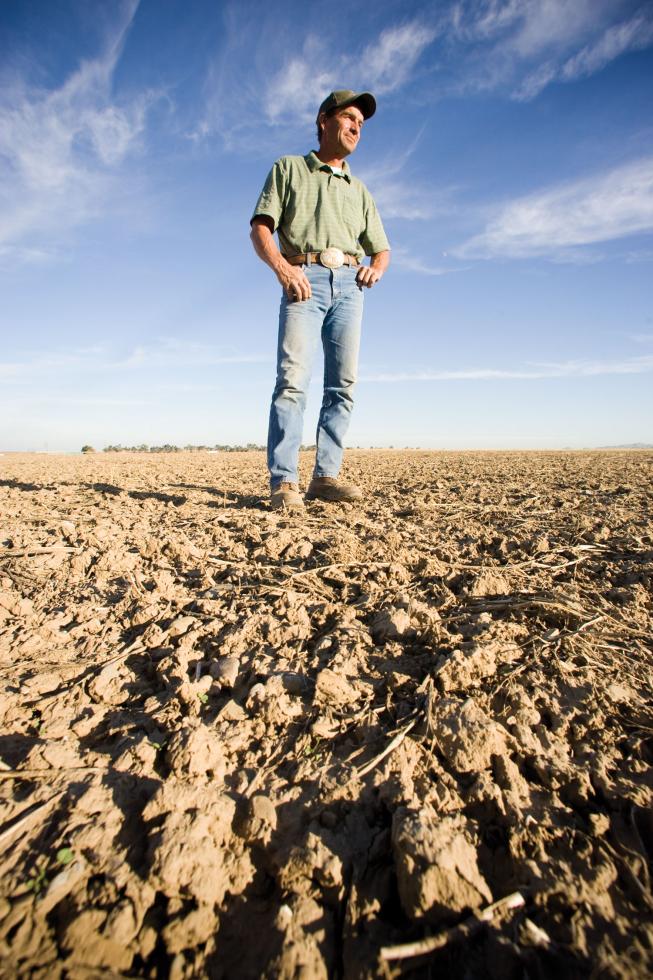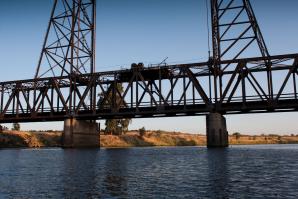This year, farmer Bill Koster fallowed 80 percent of his land,
relying on wells to keep only his almond and walnut trees alive.

In 2008, Bill Koster had his best year in three and a half decades of farming. Commodity prices hit record highs, his expenses were low and water allocation was enough to yield a decent crop, even though it was less than half his contracted amount.
Less than a year later, 80 percent of his land lies barren. He estimates he’ll lose nearly $300,000 in revenue based on crops he can’t plant and wonders if his fourth-generation family farm will be producing anything next year.
“We had a tremendous year last year,” says Koster, who owns A. & B. Koster ranch with his brother, Andrew Koster. “(I’m) almost broke right now, not even 12 months later. I mean it’s feast or famine.”
Koster’s uncertain future depends in part on how much water he’ll receive from the federal Central Valley Project next year. This year, the CVP allocation for farmers south of the Sacramento-San Joaquin Delta was initially nothing. Ultimately, 10 percent was delivered, the lowest allocation on record for that group. Recipients of State Water Project deliveries received 40 percent of their contracted amount, one of the lowest on record, says Ron Milligan, the Central Valley Project’s operations manager.
California is in its third year of drought. Combined with court-ordered pumping restrictions to protect Delta smelt and a deep recession, the water shortage has been devastating to Koster and thousands of farmers statewide.
While the Sierra snowpack was 85 percent of normal, an amount that wouldn’t make much difference in a single year, several key reservoirs were low at the beginning of the season and didn’t refill, says Wendy Martin, statewide drought coordinator for the Department of Water Resources.
Drought impacts are “catastrophic” and more severe this year than in previous years, Martin says. She attributes the severity to population growth, irregular rainfall, less snow and court-ordered pumping restrictions in the Delta that have curtailed the amount of deliverable water. Since mid-February, those restrictions have prevented the SWP from exporting 300,000 acre-feet of water.
The effects of water cutbacks are rippling through the economy. Some farms can’t plant at all, while others are struggling to keep their permanent crops alive. The cutbacks will put some farmers out of business, says Bruce Blodgett, executive director of the San Joaquin Farm Bureau Federation.
“You lose that whole chain,” Blodgett says. “It’s not just a farm impact; it’s really a community impact.”
California has long struggled with equality in water distribution. Some holders of water rights had a full supply and excess for sale, while others came up short. The west side of the San Joaquin Valley has been particularly hurt, says Blodgett, who attributes the problem to pumping restrictions in the Delta and a lack of statewide storage.
In May, UC Davis researchers estimated reductions in SWP and CVP deliveries “would result in lost agricultural gross revenue in the Central Valley of between $627 million and $710 million” in 2009, about double last year’s impacts, Martin says. Researchers estimate that in 2009 cuts to the supply of surface water will lead to losses of 31,000 to 35,000 full-time agricultural jobs in the Central Valley.
Koster, 50, says he and his brother anticipated the water shortage last year and laid off their only full-time employee. While some Central Valley farmers have replaced row crops with water-needy trees and vineyards, Koster says he keeps a balance in case of drought. This year, he fallowed 80 percent of his land, relying on wells to keep only his almond and walnut trees alive.
The Koster brothers’ farm is just off Interstate 5 in Vernalis, south of Tracy, a mix of acreage they own and lease. In 1880, their great-grandfather settled here after emigrating from Germany and farmed barley. At its height, the farm spanned nearly 2,200 acres, but in the 1960s, a death in the family forced a partial sale. Koster’s grandfather and father also farmed the land. The 821-acre farm has 614 acres in dry beans, wheat, barley and occasionally tomatoes, and 190 acres in almonds and walnuts.
Koster owns most of his equipment and installed efficient irrigation systems years ago. He’s hoping to celebrate his family’s 130th year in farming next year but doesn’t know if he’ll make it.
Koster says the state doesn’t have enough water storage to meet its urban, agricultural and environmental demands. He calls the court-ordered pumping restrictions in the Delta necessary but extreme. A zero allocation angered him initially.
“I’m done being angry about it,” he says. “I’m trying to figure out how to make it to next year. Trying to point a finger at fish or environmentalists only gets you more gray hair and weaker in the stomach. You roll with it, and you move on. That’s what farmers do.”
Recommended For You

What’s to Fallow
After Years of drought, the legislature's historic water deal is just the beginning
This is the final story in a four-part series on water. This month, we’ll wrap up by examining upcoming issues in 2010. Past installments of this series have explored water issues ranging from storage, conservation and desalination, to impacts of a peripheral canal on the Sacramento-San Joaquin Delta.
Tule Story
Researchers examine tule reeds and rice fields in the Delta
On Twitchell Island, near the Delta town of Isleton, tules covering 15 acres grow twice as tall as the average man. A gravel road separates the wetlands from a cornfield, sunken 25 feet at its lowest point. Every year, the wetlands’ soil rises a few inches, while the cornfield sinks. The discovery that tules increase land elevation in the Sacramento-San Joaquin Delta is fueling a joint experiment conducted by the state Department of Water Resources and the U.S. Geological Survey, along with UC Davis researchers, other universities and private consultants.


